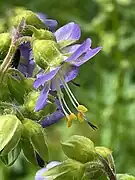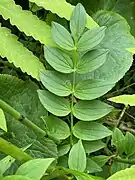| Polemonium vanbruntiae | |
|---|---|
 | |
| Green Mountain National Forest, Addison County, Vermont (June 23) | |
| Scientific classification | |
| Kingdom: | Plantae |
| Clade: | Tracheophytes |
| Clade: | Angiosperms |
| Clade: | Eudicots |
| Clade: | Asterids |
| Order: | Ericales |
| Family: | Polemoniaceae |
| Genus: | Polemonium |
| Species: | P. vanbruntiae |
| Binomial name | |
| Polemonium vanbruntiae | |
Polemonium vanbruntiae is a species of flowering plant in the phlox family Polemoniaceae.[3] It is known by the common names Appalachian Jacob's ladder, bog Jacob's-ladder, and Vanbrunt's polemonium. It is native to eastern Canada and the northeastern United States.
Description
Polemonium vanbruntiae is a perennial herb that grows erect from a horizontal rhizome,[4] reaching one meter in maximum height. The leaves are each made up of 7 to 10 pairs of lance-shaped or nearly oval leaflets. The inflorescence is a corymb of purple-blue flowers with yellow centers. The stamens and stigmas protrude from the bell-shaped corolla.
 Flower buds (June 15)
Flower buds (June 15) Flowers (June 23)
Flowers (June 23) Compound leaf (June 23)
Compound leaf (June 23)
Polemonium vanbruntiae is similar to P. caeruleum and P. reptans.
Taxonomy
Polemonium vanbruntiae was described and named by the American botanist Nathaniel Lord Britton in 1892.[2] In large part, Britton based his description on specimens collected by Mrs. Van Brunt in the Catskill Mountains in Ulster County, New York in 1890: "I take pleasure in dedicating it to the lady who has supplied such fine and numerous specimens".[5][6] Consequently, Polemonium vanbruntiae Britton is commonly called Van Brunt's Jacob's-ladder (or Vanbrunt's polemonium).[7][8]
Distribution and habit
Polemonium vanbruntiae can be found from New Brunswick and Quebec south to Maryland and West Virginia.[3][9] It is not common anywhere but it is probably most abundant in New York.[1][10] It tolerates a wide variety of wetland habitat types including swamps, bogs, marshes, and wet spots along roadsides. Its habitat is often saturated, but not flooded.[11]
Ecology
Polemonium vanbruntiae reproduces both sexually and vegetatively, although the relative importance of each is not known.[1] Plants typically flower from mid-June to late-July.[12]
Conservation
The global conservation status of Polemonium vanbruntiae is vulnerable (G3G4).[1] It is imperiled (S2) in Maryland, Quebec, Vermont, and West Virginia; critically imperiled (S1) in Maine, New Brunswick, and Pennsylvania; and presumed extirpated (SX) in New Jersey.
The main threat to the species is the destruction and degradation of wetland habitat, for example, by flooding during dam construction. Habitat is also lost outright in the conversion to agriculture and other uses.[11] Succession may be a threat in some areas, as the plant's open habitat becomes shaded when large and woody vegetation moves in.[1] It is adapted to some level of disturbance in the habitat.
Uses
Polemonium vanbruntiae is sometimes cultivated for garden use.[11]
References
- 1 2 3 4 5 "Polemonium vanbruntiae". NatureServe Explorer. NatureServe. Retrieved 17 June 2023.
- 1 2 "Polemonium vanbruntiae Britton". International Plant Names Index (IPNI). Royal Botanic Gardens, Kew; Harvard University Herbaria & Libraries; Australian National Botanic Gardens. Retrieved 17 June 2023.
- 1 2 "Polemonium vanbruntiae Britton". Plants of the World Online. Royal Botanic Gardens, Kew. Retrieved 17 June 2023.
- ↑ Britton (1892), Plate CXXXI.
- ↑ Britton (1892), p. 224.
- ↑ "Type of Polemonium vanbruntiae Britton [family Polemoniaceae]". JSTOR. Retrieved 19 June 2023.
- ↑ "Polemonium vanbruntiae Britton". Canadensys.net. Retrieved 19 June 2023.
- ↑ USDA, NRCS (n.d.). "Polemonium vanbruntiae Britton". The PLANTS Database (plants.usda.gov). Greensboro, North Carolina: National Plant Data Team. Retrieved 19 June 2023.
- ↑ "Polemonium vanbruntiae". State-level distribution map from the North American Plant Atlas (NAPA). Biota of North America Program (BONAP). 2014. Retrieved 19 June 2023.
- ↑ "Polemonium vanbruntiae". County-level distribution map from the North American Plant Atlas (NAPA). Biota of North America Program (BONAP). 2014. Retrieved 19 June 2023.
- 1 2 3 "Bog Jacob's-ladder (Polemonium vanbruntiae)". Center For Plant Conservation. Retrieved 17 June 2023.
- ↑ "Jacob's Ladder Polemonium vanbruntiae Britt.". New York Natural Heritage Program. Retrieved 19 June 2023.
Bibliography
- Britton, N. L. (July 1892). "New or noteworthy North American phanerogams, VI". Bulletin of the Torrey Botanical Club. New York. 19 (7): 219–226. Retrieved 19 June 2023.
External links
- Deller, MaryBeth. "Appalachian Jacob's ladder (Polemonium vanbruntiae)". Plant of the Week. U.S. Forest Service. Retrieved 17 June 2023.
- "Understanding and Conserving Appalachian Jacob's Ladder (Polemonium vanbruntiae)". U.S. Forest Service. Retrieved 17 June 2023.
- "Polemonium vanbruntiae Britt.". Maine Department of Agriculture, Conservation & Forestry. Retrieved 17 June 2023.
- "Polemonium van-bruntiae". Center For Plant Conservation. Archived from the original on 2011-10-26. Retrieved 17 June 2023.
- "Polemonium vanbruntiae — bog Jacob's-ladder". Go Botany. Native Plant Trust. Retrieved 19 June 2023.
- "Polemonium vanbruntiae". Lady Bird Johnson Wildflower Center. Retrieved 19 June 2023.
- "Polemonium vanbruntiae". Pennsylvania Natural Heritage Program. Pennsylvania Department of Conservation and Natural Resources. Retrieved 19 June 2023.
- King, Warren (18 May 2018). "Status of Appalachian Jacob's-Ladder in Vermont". Rhodora. 120 (981): 42–51. doi:10.3119/17-07.
- "Polemonium vanbruntiae". New York Flora Atlas. Retrieved 19 June 2023.
